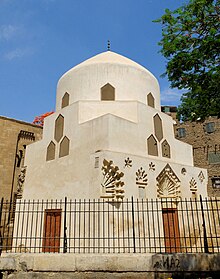| Mausoleum of Shajar al-Durr | |
|---|---|
 | |
| Religion | |
| Affiliation | Islam |
| Location | |
| Location | Cairo, Egypt |
| Geographic coordinates | 30°01′33.3″N 31°15′7.5″E / 30.025917°N 31.252083°E |
| Architecture | |
| Type | Mausoleum |
| Style | late Ayyubid architecture |
| Completed | circa 1250 |
| Dome(s) | 1 |
The Mausoleum of Shajar al-Durr is a mausoleum housing the tomb of the female Ayyubid sultan Shajar al-Durr in Cairo, Egypt. It is located on al-Khalifa Street or Shurafa Street, in a neighbourhood on the edge of the al-Qarafa cemeteries. Its construction was commissioned by Shajar al-Durr herself and it is believed to have been built in the Islamic year 648 AH (1250 CE).[1][2][3] Shajar al-Durr was notable for being the only female Muslim ruler in Egyptian history and for playing a crucial role in the transition from Ayyubid rule to Mamluk rule.[4][3] The mausoleum serves as the formal resting place of the queen and commemorates her legacy. Architectural features of this structure, along with the broader architectural patronage of Shajar al-Durr, influenced future Mamluk architecture.[5]
- ^ "[Conservation of the Mosque of Shajar al-Durr] | American Research Center In Egypt". www.arce.org. Retrieved 2021-12-05.
- ^ Behrens-Abouseif, Doris (2007). Cairo of the Mamluks: A History of Architecture and its Culture. The American University in Cairo Press. pp. 114–116. ISBN 9789774160776.
- ^ a b Williams, Caroline (2018). Islamic Monuments in Cairo: The Practical Guide (7th ed.). Cairo: The American University in Cairo Press. pp. 142–144.
- ^ AlSayyad, Nezar (2011). "Fortress Cairo: From Salah al-Din to the Pearl Tree". Cairo: Histories of a City. The Belkap Press of Harvard University Press. pp. 77–92. ISBN 9780674047860.
- ^ Ruggles, D.F. (2020). Tree of pearls: The extraordinary architectural patronage of the 13th-century Egyptian slave-queen Shajar al-Durr. Oxford University Press.